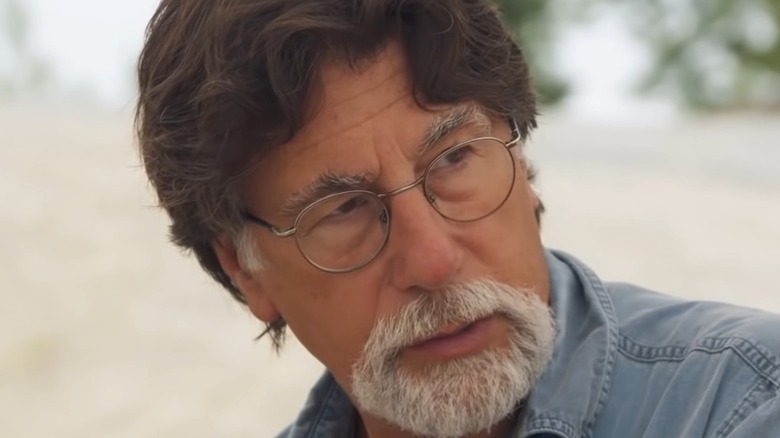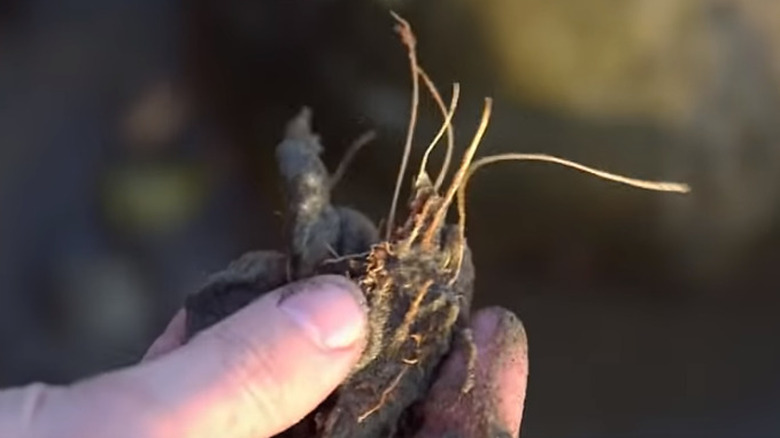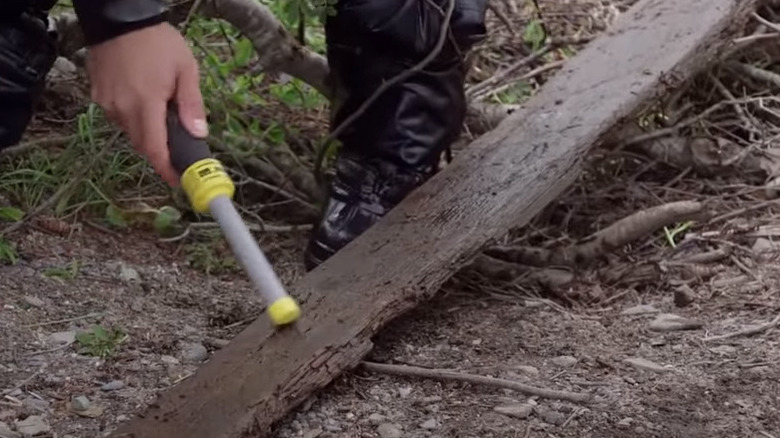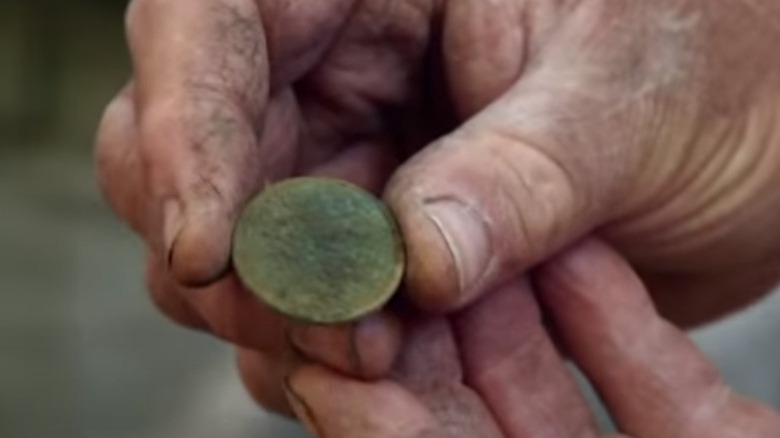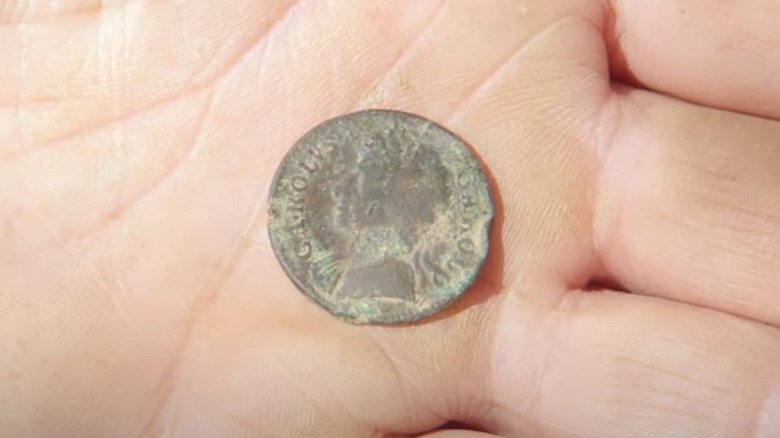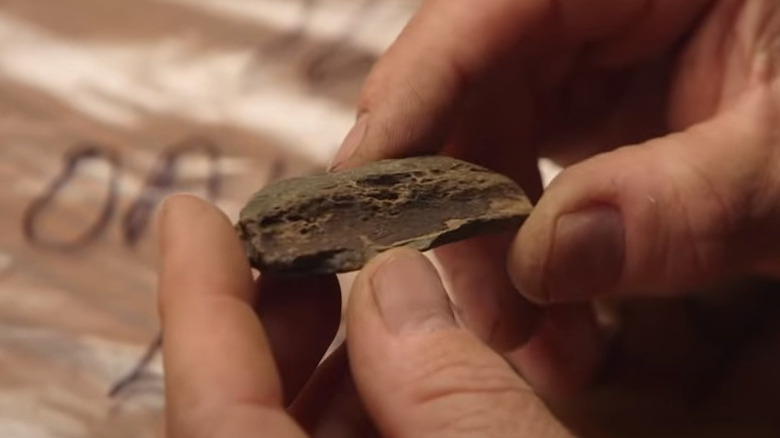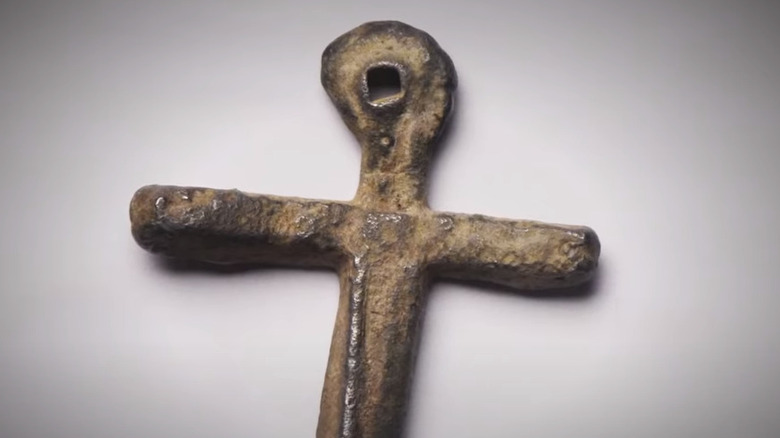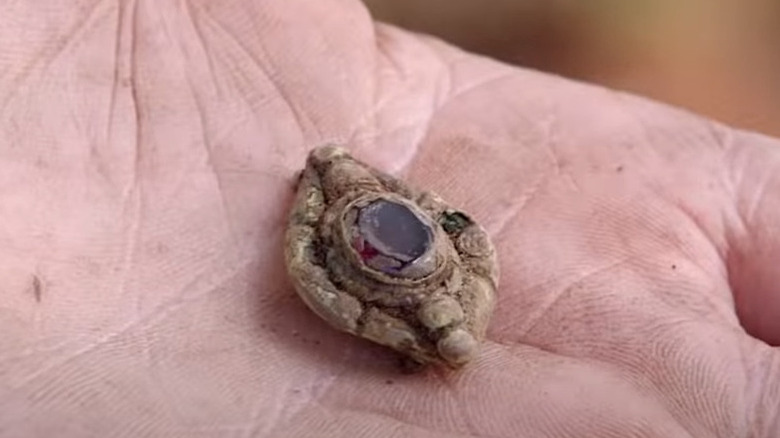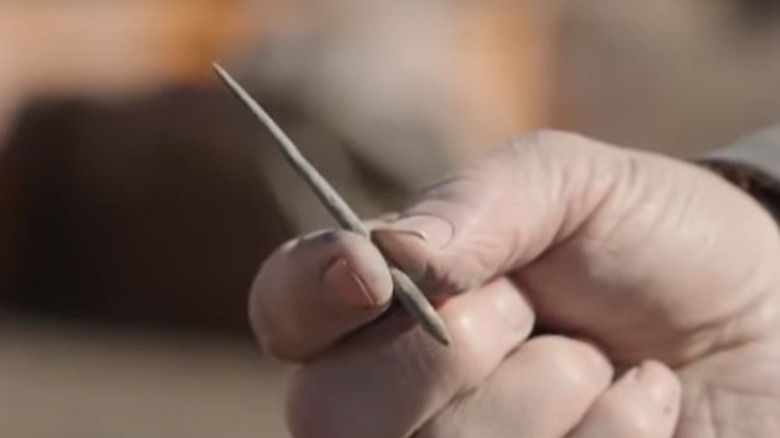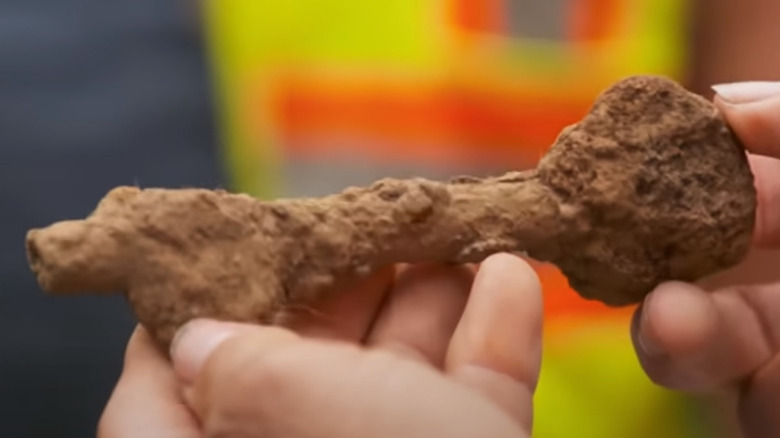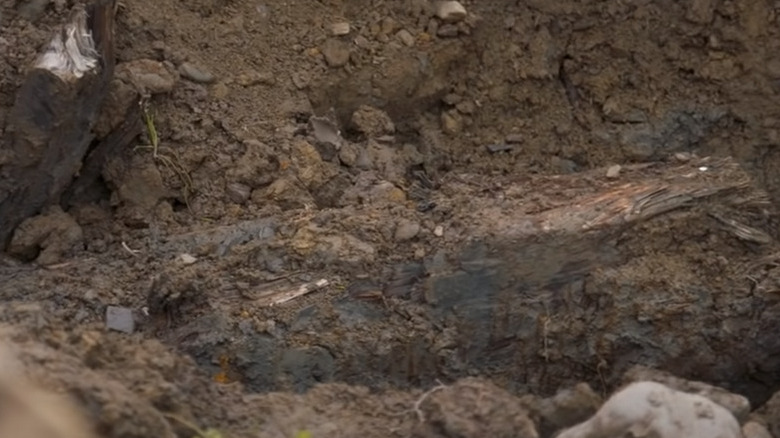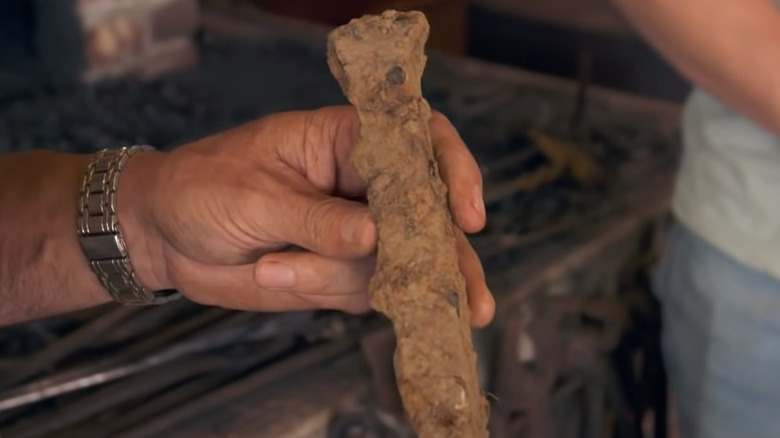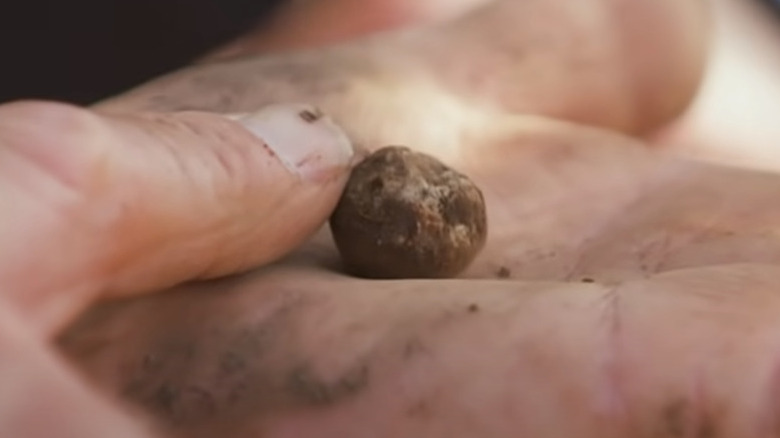Every Exciting Discovery Of The Lagina Brothers On The Curse Of Oak Island
The History Channel's "The Curse of Oak Island" follows brothers Marty and Rick Lagina, along with other regular team members, on their quest to find the entrance to the rumored money pit on Oak Island — and to understand the history of the island along the way. Oak Island is located on the southern shores of Nova Scotia, Canada. Rumors of treasure on the island began in the late 1700s, and continue today. These rumors say pirates like Blackbeard and Captain Kidd left their treasure there, that Shakespeare's original manuscripts were buried there, and that secret societies once lived on the island.
Many have explored and excavated the island over the years, but no one has been able to solve its mysteries or find its rumored treasure. Over the course of multiple seasons, and starting even before filming began, Marty, Rick, and their team have found a variety of artifacts supporting several of the theories of the island. However, not all of the things they find are cause for celebration. Let's look at every exciting find from "The Curse of Oak Island," ranging from artifacts that reinforce long-shared theories to those that introduce new ones.
Coconut fiber (Season 1, Episode 2)
Dan Henskee, a treasure hunter who has been searching Oak Island since his first visit in 1965, found a pocket of coconut fiber in Smith's Cove in the 1990s. Twenty years later, he and Jack Begley searched for the fiber during the Season 1 episode "The Mystery of Smith's Cove." Relying on Dan's memory alone, they began digging through the rocks and mud present in the area, hoping to beat the tide. After being joined by Peter Fornetti (Marty and Rick's nephew) and Alex Lagina (Marty's son), the group made headway and found several pieces of coconut fiber after digging two feet down.
This find is exciting because coconut trees aren't native to Oak Island. Coconut trees are found natively in northeast Australia, the Philippines, and New Guinea. While the trees have been introduced throughout the world, they were not introduced in Canada, meaning the coconut fibers had to be brought to Oak Island. This raises the question: who brought them and why?
Ship plank (Season 4, Episode 3)
While searching a stretch of Oak Island's swamp, professional diver Tony Sampson and Jack Begley found a large plank of wood that they estimated to be 18 feet long. It was initially assumed that this was the cause of the anomalies showing up on their equipment, with readings showing that there were a ton of metal artifacts in the area. However, after bringing the plank to shore and sweeping it with a handheld metal detector, they discovered the plank wasn't the cause of the anomalies. That may have been a disappointment, but it left them with a new hypothesis: Perhaps the wood was planking from a ship.
The plank was sent off for carbon dating, which dated it anywhere from 1680 to 1735. This information is consistent with the theories of the island, even adding credibility to the theory that there is a ship buried in the swamps of Oak Island. While finding the plank didn't answer the riddle they intended to solve with their search, it opened up the door to new information and reinforced Rick's theory that the swamp is the key to solving Oak Island's mystery.
Copper coin (Season 4, Episode 6)
Alex Lagina, Jack Begley, and metal detection expert Gary Drayton took a look at Lot 6 in Season 4. Lot 6 was owned by Samuel Ball, a former slave from the United States that later lived on Oak Island. He was considered one of the wealthiest residents of the island, owning 36 acres as part of a cabbage farm. While searching the lot, they found a coin, potentially made of copper, with a visible face. The coin is thought to be British, minted from the late 1600s to early 1700s, which would place it under the rule of King William III.
While this is one of many coins found on land owned by Ball, it was one of the first in the area, which later turned into a trove of other coins from the 1700s. It is unclear whether the copper coin belonged to Samuel Ball or if he found it while doing treasure hunting himself, but its discovery led to other discoveries in the area.
King Charles II coin (Season 5, Episode 3)
Rick, Marty, Gary Drayton, and Oak Island resident Dave Blankenship searched Lot 16 during Season 5. Their hope was to determine who was on Oak Island before the discovery of the money pit. Lot 16 is considered a spoils pile, where dirt from Robert Dunfield's 1960 excavation of the money pit was placed. Gary guided the group to a clearing on the lot he thought was the perfect place to start metal detecting. After finding pieces of modern nails, the team stumbled upon two coins, one of which bore the likeness of King Charles II, with Gary reading the date on the coin as 1673.
Coins bearing King Charles II's profile were minted after he restored the British monarchy in 1660. Several varieties and denominations were printed, with copper coins initially minted from 1672 to 1675. The coins have the phrase "Carolvs" on them, which means "Charles" in Latin. They were printed until King Charles II's death in 1685. While this find may not feel exciting, it can help date deposits and provides further evidence the British were once on the island.
Bone fragments (Season 5, Episode 5)
While searching around the money pit, Rick and the team found what appeared to be a piece of wood while looking through the contents of borehole H-8, thought to be located directly over the money pit. The mysterious find was discovered between 160 and 165 feet below the surface, putting it pretty far down in the ground. Geologist Terry Matheson confirmed in the field it wasn't a rock, and the team discussed the possibility that it could be a piece of Lignum vitae, a tropical tree known for its dense wood. This wood was often used to build sea vessels from the 1500s through recent times, even to build crafts like the USS Nautilus.
When they shared the find with archaeologist Laird Niven, he informed them it was bone, not wood. The team was very surprised to find bone but was curious to see where the find would lead. After sending this fragment, along with another one found in the borehole, off to Saint Mary's University, Dr. Timothy Frasier told the team he was able to conduct DNA analysis on both samples. The first fragment was determined to come from someone with Middle Eastern ancestry and the second from someone with European ancestry. Finding bone in the money pit leads to questions like how it got there, who these people were, and what they were doing on Oak Island.
Lead cross (Season 5, Episode 10)
Rick and Gary Drayton decided to take advantage of their free time to explore Smith's Cove when they made this find. Hoping to find something in the rocks between the beach and an old dam because high tide could deposit something there, the two found a small but heavy cross with a square hole. Gary was pretty excited about the find, claiming that the cross looked like something from medieval Europe, produced sometime between 1200 and 1600 based on its style.
With the help of geochemist Tobias Skowronek, the team found out the lead isotopes in the cross are connected to Europe, but not with the rock quarries used from the 1400s to 1600s. A match was found with quarries dating before the 1400s, where medieval mining took place. Skowronek believed the cross was consistent with something produced in southern France, adding a new layer to the find. This information provides key links to the Knights Templar, a group of Christians dedicated to protecting Europeans who traveled to the Holy Lands, adding another item to the list of finds the team has linked to the Templars.
Jeweled brooch (Season 6, Episode 1)
Rick and Gary Drayton found this item while searching Lot 21, owned by Daniel McGinnis, who is credited — along with two friends — with discovering the money pit in 1795. After his discovery, he moved to Oak Island and continued searching for treasure. Upon discovering an old hinge with the metal detector, Rick and Gary found the fairly ornate brooch, which has what looks like a gem in the center.
In the next episode, "Gold Rush," Rick, Marty, and Dave Blankenship went to the Alberta College of Art and Design to have the gem analyzed. Charles Lewton-Brain, a professional gemologist and goldsmith, determined that the brooch found on Lot 21 had a stone made of leaded glass, though the brooch found on Lot 8 with a similar red stone was identified as a garnet. Lewton-Brain added that glass gems have been made for 500 years, potentially dating the brooch. Marty, Alex Lagina, and Marty's business partner Craig Tester then went to Saint Mary's University to see if the brooch was made of real gold. Dr. Christa Brosseau and Dr. Xiang Yang used an electron microscope to determine that it was crafted using gold and pure copper, making it the first piece of gold found on Oak Island.
Booby trap spike (Season 7, Episode 20)
While digging at the money pit in Season 7, the crew found an old tunnel called Shaft 6. This helped reinforce the location of the money pit for the team, but what they found in the dirt they removed gave them even more confirmation. While metal detecting the pile, Gary Drayton found what looked like a needle in the mounds of clay. The dirt it was found in came from a depth of 100 feet; its discovery puzzled the team, but they believed it was from a feature near or in the money pit.
Marty, Gary, and Alex Lagina took the find to Carmen Legge, a blacksmith. At first, Legge was unsure what an object like that could be doing so deep in the ground, saying it had no practical purpose — although he also pointed out that items like that have been used as booby traps in the past. Legge showed the group where he thought the object was driven into something, maybe even wood, and dated the object anywhere from the 1500s to the mid-1700s. The clear implication: It may have been used as a spike in a piece of wood as a way to protect the money pit. If the team wasn't close to the pit before, they certainly felt closer with this find.
Ox shoes (Season 8, Episode 7)
After clearing a portion of Lot 13, Gary Drayton and Peter Fornetti went metal detecting because the team believed there were more artifacts related to the Knights Templar on the lot. After digging based on readings from the detector, the two found a large unknown artifact initially thought by Gary to be a linchpin. Rick, Terry Matheson, and Charles Barkhouse came over to see the find, and in addition to the linchpin, which the team agreed had a strong visual resemblance to a key, three ox shoes were found, which Gary thought were leading from the beach to the money pit.
Ox shoes were previously found on Lot 15. Alex Lagina and Jack Begley took them from Lot 15 to Legge, who confirmed they were British ox shoes made anywhere from 1650 to 1750. More were later found on Lot 26, another lot owned by Samuel Ball. Oxen were used for farming, so it makes sense to find them on Oak Island — but oxen were also used in military operations, and the team believed there was some type of British military presence on Oak Island. The ox shoes found on Lot 13 reinforce the theory that cargo was being unloaded in the swamp and taken to the money pit.
Timber from Lot 18 (Season 9, Episode 5)
During Season 9, Rick, Gary Drayton, Jack Begley, and heavy equipment operator Billy Gerhardt dug on Lot 18, which is where excavated dirt was placed during the Dunfield excavation. This dirt was never searched, so the team decided to go through it for missed objects. While digging through and metal detecting, Jack stumbled on a large timber; Gary stated it looked like the timber had a fastener, which the metal detector seemed to confirm, and they were confident they could date the timber with it. Jack found additional pieces of timber in the area, ones he believed were from a ship.
The team believed the initial timber came from the money pit and that they could follow the timber back to it. This could mean that the excavations in the 1960s came close to the money pit, but could never reach it. If the timber can lead them back, could the team reach the pit? Could this timber also be from a ship buried on Oak Island? As one of the more recent finds, we'll have to see where it leads the team.
Iron spike (Season 9, Episode 10)
Season 9 brought several exciting finds, including this iron spike from Lot 32. Marty and Gary Drayton found the spike while searching the lot for additional clues, and Gary noted it was very heavy, likely made of raw iron, but thought it was too big to be from a railroad. Marty suggested it was further evidence of the wharf the team believed was on that side of the island.
Marty, Alex Lagina, and Jack Begley took the spike to their blacksmithing expert Carmen Legge. He believed it to be an anchor, used to anchor ships to rocks, and dated it to 1710 to 1740, noting it was clearly well used because of the mushroomed top. This could be linked to a ship log, dated 1746, that was found in the Nova Scotia archives and detailed a failed expedition by the French to take back the region from the British. What's interesting is that the leader of the expedition can trace their family tree back to the Knights Templar, adding another link to the group. The log also described an expedition to hide a large amount of treasure on a "wooded island." Could that treasure be what's in the money pit?
Musket ball (Season 9, Episode 14)
Lot 32 is the home of numerous exciting finds, including one of the most interesting discoveries yet: While metal detecting on the lot, Gary Drayton and Alex Lagina found a musket ball that Alex believed had been fired. Gary noted how heavy the ball was, saying one like this was used anywhere from the late 1500s to mid-1800s. The finding goes with other military-related artifacts found on the lot, like a lead bag seal and military buttons.
The discovery raises a lot of questions. Why was there a fired musket ball near the potential site of a wharf? What type of encounter might have happened for muskets to be fired? Could it have been used in an altercation over the treasure being placed in the money pit? Dr. Christa Brosseau told the team that lead bag seals were popularly used from 1450 to 1730, which can help narrow down the time such an altercation may have happened. With exciting artifacts continuing to come out of Lot 32, there are certainly more finds waiting for the team as the series continues.
